

Grade Differently: 7 Categories To Create Learning Badges. Grade Differently: 7 Categories To Create Learning Badges by Terry Heick How can you help students see their own progress?

And use that to motivate them? Encouragement mechanics–a kind of gamification–is one approach. And note, you needn’t make that lesson or unit feel like a ‘video game.’ So here, we’d be taking a lesson from games and applying them to student progress. On the surface, they seem a bit like the gold stars of yesteryear, and they are–but they’re better. Like encouragement mechanics, learning badges often get confused with gamification as well when in fact they are just strategies that can be used to realize gamification.
Put another way, seeing one’s progress is a strategy for encouragement. But they don’t have to be used to encouraged; they can be used to uncover, reveal, and emphasize. This is all oversimplified, of course. 5 Ways to Gain Clarity Before Moving Forward. There are many things that seem to fall to the wayside when life seems to travel as fast as technology changes, which we all know is lightning quick.
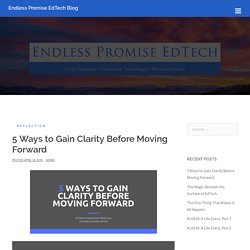
One of the first things to go away is the time taken to truly gain clarity before moving forward versus launching directly into the next task, project, etc. The key to great and consistent work, however, is not jumping right into the deep end without preparing. 38 Prompts Merging Reflective Thinking With Bloom's Taxonomy. 38 Prompts Merging Reflective Thinking With Bloom’s Taxonomy contributed by Peter Pappas My interest in reflective thinking is rooted in a simple but powerful statement by Donald Finkel who wrote that teaching should be thought of as “providing experience, provoking reflection” (Teaching with Your Mouth Shut).
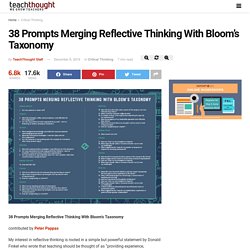
Most school mission statements include a reference to ‘fostering life-long learners.’ Nonetheless, if you walk through some schools you will see adults telling students what’s worth knowing and then evaluating the students on their success. I doubt that inspires students to take responsibility for their education. Unfortunately, self-reflection is rarely taught in school. I developed my Taxonomy of Reflection in an effort to provide a schema of prompts that could be used by students, teachers, and administrators to hone their reflective skills.
Below are 38 examples of higher-order reflective prompts. As always, comments are welcome! 1. Student 2. Social media as powerful method of learning – the evidence. Discussion around social media and learning tends to focus on the networking effects; the fact that you are in touch with others and gain from that nexus of expertise and knowledge.
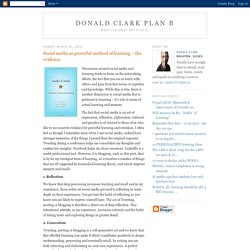
While this is true, there is another dimension to social media that is pertinent to learning – it’s role in terms of actual learning and memory. The fact that social media is an act of expression, reflection, elaboration, retrieval and practice is of interest to those of us who like to see concrete evidence for powerful learning and retention. I often feel as though I remember more when I use social media, indeed have stronger memories of the things I posted than the original exposure. Tweeting during a conference helps me consolidate my thoughts and capture key insights. Facebook helps me share resources. 1. We know that deep processing increases learning and recall and in my experience, those active on social media get used to reflecting in some depth on their experiences. 2. 3. 4. The Use of Social Media in School.
Share this infographic on your site!

Embed this infographic on your site! The editors at Best Masters in Education decided to research the topic of: Teens are actively Tweeting, Posting, Liking, and Commenting all across Social Media and there doesn't seem to be an end in sight. Increasingly, teachers and schools are attempting to leverage the engaging qualities of Social Media for use in the classroom and beyond - connecting students, teachers, and parents better than ever before. Every Student Should Have a Digital Portfolio. Every student should have a collection of personal bests—a cloud-based story of their development and artifacts of accomplishment that’s easily shareable in full or in part and organized for presentation.
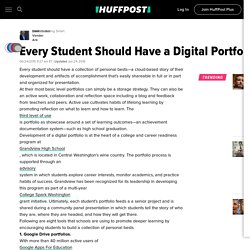
At their most basic level portfolios can simply be a storage strategy. Collaborative Learning Spaces: Classrooms That Connect to the World. Editor's note: This post is co-authored by Fran Siracusa, co-founder of and educational technologist for Calliope Global.
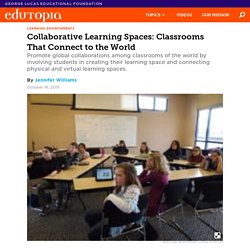
Profile of a 2020 learner - City & Guilds. Digital Portfolios Best Practices Infographic. Today's students are the most accomplished and the most connected.
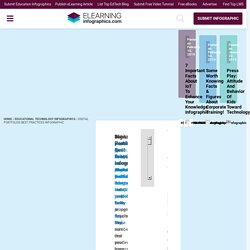
Back in the day, no one needed a resume until they were out of school. Now, even middle schoolers are being asked to submit completed resumes to apply for summer programs. This is why an up to date, professional portfolio is now a necessity for students. A portfolio's goal is to showcase your talents, skills, projects and recognitions. Beyond the numbers on your transcript, portfolios provide insight into your character and strengths as a person as a whole. When you are building a portfolio, each item needs to have proper details. Set yourself up for success.